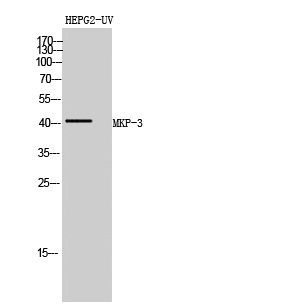MKP-3 Polyclonal Antibody
- Catalog No.:YT2774
- Applications:WB;IHC;IF;ELISA
- Reactivity:Human;Mouse;Rat
- Target:
- MKP-3
- Fields:
- >>MAPK signaling pathway;>>Transcriptional misregulation in cancer;>>Acute myeloid leukemia
- Gene Name:
- DUSP6
- Protein Name:
- Dual specificity protein phosphatase 6
- Human Gene Id:
- 1848
- Human Swiss Prot No:
- Q16828
- Mouse Gene Id:
- 67603
- Mouse Swiss Prot No:
- Q9DBB1
- Rat Gene Id:
- 116663
- Rat Swiss Prot No:
- Q64346
- Immunogen:
- The antiserum was produced against synthesized peptide derived from human DUSP6. AA range:61-110
- Specificity:
- MKP-3 Polyclonal Antibody detects endogenous levels of MKP-3 protein.
- Formulation:
- Liquid in PBS containing 50% glycerol, 0.5% BSA and 0.02% sodium azide.
- Source:
- Polyclonal, Rabbit,IgG
- Dilution:
- WB 1:500 - 1:2000. IHC 1:100 - 1:300. IF 1:200 - 1:1000. ELISA: 1:20000. Not yet tested in other applications.
- Purification:
- The antibody was affinity-purified from rabbit antiserum by affinity-chromatography using epitope-specific immunogen.
- Concentration:
- 1 mg/ml
- Storage Stability:
- -15°C to -25°C/1 year(Do not lower than -25°C)
- Other Name:
- DUSP6;MKP3;PYST1;Dual specificity protein phosphatase 6;Dual specificity protein phosphatase PYST1;Mitogen-activated protein kinase phosphatase 3;MAP kinase phosphatase 3;MKP-3
- Observed Band(KD):
- 42kD
- Background:
- The protein encoded by this gene is a member of the dual specificity protein phosphatase subfamily. These phosphatases inactivate their target kinases by dephosphorylating both the phosphoserine/threonine and phosphotyrosine residues. They negatively regulate members of the mitogen-activated protein (MAP) kinase superfamily (MAPK/ERK, SAPK/JNK, p38), which are associated with cellular proliferation and differentiation. Different members of the family of dual specificity phosphatases show distinct substrate specificities for various MAP kinases, different tissue distribution and subcellular localization, and different modes of inducibility of their expression by extracellular stimuli. This gene product inactivates ERK2, is expressed in a variety of tissues with the highest levels in heart and pancreas, and unlike most other members of this family, is localized in the cytoplasm. Mutations in t
- Function:
- catalytic activity:A phosphoprotein + H(2)O = a protein + phosphate.,catalytic activity:Protein tyrosine phosphate + H(2)O = protein tyrosine + phosphate.,function:Inactivates MAP kinases. Has a specificity for the ERK family.,similarity:Belongs to the protein-tyrosine phosphatase family. Non-receptor class dual specificity subfamily.,similarity:Contains 1 rhodanese domain.,similarity:Contains 1 tyrosine-protein phosphatase domain.,
- Subcellular Location:
- Cytoplasm .
- Expression:
- Expressed in keratinocytes (at protein level).
- June 19-2018
- WESTERN IMMUNOBLOTTING PROTOCOL
- June 19-2018
- IMMUNOHISTOCHEMISTRY-PARAFFIN PROTOCOL
- June 19-2018
- IMMUNOFLUORESCENCE PROTOCOL
- September 08-2020
- FLOW-CYTOMEYRT-PROTOCOL
- May 20-2022
- Cell-Based ELISA│解您多样本WB检测之困扰
- July 13-2018
- CELL-BASED-ELISA-PROTOCOL-FOR-ACETYL-PROTEIN
- July 13-2018
- CELL-BASED-ELISA-PROTOCOL-FOR-PHOSPHO-PROTEIN
- July 13-2018
- Antibody-FAQs
- Products Images

- Western Blot analysis of HEPG2-UV cells using MKP-3 Polyclonal Antibody diluted at 1:500

- Immunofluorescence analysis of HeLa cells, using DUSP6 Antibody. The picture on the right is blocked with the synthesized peptide.

- Immunohistochemistry analysis of paraffin-embedded human brain tissue, using DUSP6 Antibody. The picture on the right is blocked with the synthesized peptide.



